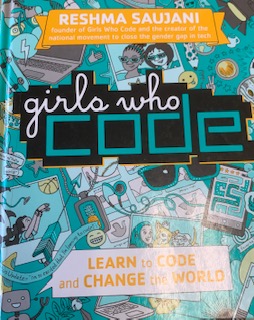Why coding?
WELCOME!
Yes, you! The one reading this book. So glad you made it.
What brings you to coding?
Maybe you’re already into COMPUTER SCIENCE and want to learn how
to do more.
If so, that’s great!
Maybe a parent or grandparent or teacher told you that coding is a
valuable skill for you to nuture and made you sign up for a class, but you’re not really sure if it’s for you.
That’s okay, too.
Maybe you don’t know anything about coding and just liked our cover art
That works for us!
Whatever the reason, we’re glad you’ve picked up this book, and we’re
glad you’re here. And you’re in good company!
The first thing to know about coding is that it’s about way more than
just computers. It’s about having fun. It’s about collaborating with your friends. It’s something everyone (not just boys) can do.
And it’s about creating, imagining, and inventing awesome new stuff
based on whatever you’re interested in. Like turning a toy car into a robot. Or making a WEBSITE* for your dog-walking business. Maybe you want
to DESIGN a smart bracelet that can
remind you when to do your homework or practice the piano. Or an app to
keep track of your sprint times when you’re training. How about an interactive sound and light display for the next school play? Or an LED headband that can change color to match what you’re wearing?
You can do all this stuff, and a whole lot more, by learning to code.
And I’ve got some news for you:
The major, earth-shattering trick to COMPUTER CODING is .. it’s mostly problem-solving!
The actual code-writing part is just a small piece of a process that
uses the thinking and planning skills you already have and use every day in your life. So let’s get started.
First of all, who can tell me what coding is?
OOOH, I know this. It’s how you tell a computer what to do.
That’s right. Coding is, very simply, writing commands to instruct a computer to do something in a programming language it can understand.
There are actually hundreds of different programming languages used
to give instructions to a computer. Which one you use depends on what you need the computer to do. When you learn to code, you learn to “speak” one of these languages so that you can communicate directly to the computer.
YEAN, BUT DON’T WE ALREADY TELL OUR COMPUTERS WHAT TO DO BY CLICKING ON THE MOUSE AND NAVIGATING DIFFERENT MENUS AND APPS? WHY DO I NEED TO KNOW
CODING, TOO?
Because coding is an amazing tool that will allow you to use your com-
puter in ways you haven’t even dreamed up yet. Sure, you can already do stuff on your computer, your tablet, or your phone, but that’s because at some point, somewhere, a programmer had an idea for that app or program, then wrote the CODE to make it work. That person’s code created the icons and buttons and shortcuts you use to control your device. This is the software that runs the machine. But using software is not the same as writing code.
By learning to code, you no longer have to just use the programs and
apps that somebody else created -you can build them yourself! Like a
best friend birthday reminder app, or a website for your drama club.
SOFTWARE VS HARDWARE
SOFTWARE is the set of programs and applications that make a computer run. It’s a collection of code, designed and written by programmers.
Software includes everything from apps that let you put fun filters on your photos to games that let you take care of a virtual dog or fight villains. Software also includes the computer programs that let you write
your English essay.
HARDWARE refers to the physical parts of the computer itself: the screen, the keyboard the camera, and more. These are usually designed and built
by engineers. Your phone and tablet are also examples of hardware.
Another great reason to learn to code: it helps you understand, design
and work with the technology of the future.
Comprehension Questions
1. What exactly is coding?
A. Coding is instructing a computer to do something in a programming language it can understand.
B. Coding is clicking on the mouse and navigating different menus and apps.
C. Coding refers to the physical parts of a computer.
A. Make a website for your dog-walking business, make an interactive sound and light display, or keep track of your sprint times when you're training.
B. Coding allows you to use the software on your devices.
C. Coding limits your use of applications and other software.
Your Thoughts
Vocabulary
4. List any vocabulary words below.

